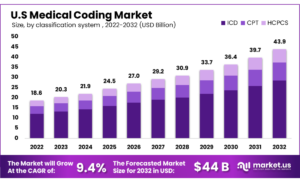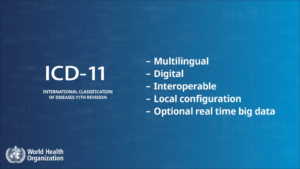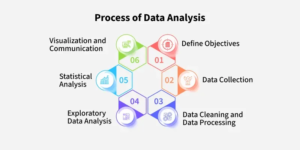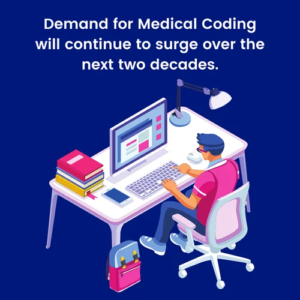Future of Medical Coding in the USA – Trends and Opportunities in 2025
Future of Medical Coding in the USA
Medical coding is a vital component of the healthcare industry, ensuring accurate documentation, billing, and reimbursement for medical services.
As the healthcare landscape continues to evolve, medical coding is undergoing significant changes driven by technology, regulatory updates, and increasing demand for skilled professionals.
In 2025, the future of medical coding in the USA looks promising, with new opportunities emerging due to advancements in artificial intelligence (AI), automation, and value-based care models.
Also Read: Top 20 Medical Coding Companies in India
Understanding these trends can help medical coders adapt to industry changes and position themselves for long-term success.
In this article, we’ll explore the top trends shaping the future of medical coding and the key opportunities for coders in the USA in 2025.
✅ Why Medical Coding is Important
Medical coding is essential for the healthcare system as it:
- Translates medical diagnoses and procedures into standardized codes (ICD-10-CM, CPT, HCPCS).
- Ensures accurate billing and reimbursement.
- Supports healthcare analytics and research.
- Helps providers comply with insurance and federal regulations.
- Facilitates smooth communication between healthcare providers and insurance companies.
As healthcare services increase in complexity, the demand for skilled medical coders is also rising. The US Bureau of Labor Statistics (BLS) projects a 7% increase in medical coding jobs from 2021 to 2031, faster than the average for all occupations.
🚀 Top Medical Coding Trends in 2025

1. Increased Adoption of Artificial Intelligence (AI) and Automation
AI and machine learning are transforming the medical coding process by automating repetitive tasks and improving accuracy.
🔹 How AI is Changing Medical Coding:
1. AI-based software can analyze medical records and assign codes automatically.
2. Machine learning algorithms improve accuracy by identifying coding errors.
3. Automated coding systems can reduce turnaround time and increase efficiency.
🔹 Opportunities for Coders:
1. Coders will need to adapt to working alongside AI-based coding systems.
2. Skilled coders will be needed to train AI algorithms and monitor coding accuracy.
3. AI will create opportunities for medical coders to focus on more complex cases requiring human expertise.
2. Shift Toward Value-Based Care
The US healthcare system is shifting from a fee-for-service model to a value-based care model, where reimbursement is tied to patient outcomes rather than the volume of services provided.
🔹 Impact on Medical Coding:
1. Increased need for accurate diagnosis codes to measure patient outcomes.
2. Greater focus on risk adjustment coding to reflect the severity of patient conditions.
3. Higher demand for coders with expertise in HCC (Hierarchical Condition Category) coding.
🔹 Opportunities for Coders:
✅ Coders with experience in HCC and value-based care will be in high demand.
✅ Opportunities to work in auditing and compliance roles related to value-based care models.
3. Expansion of Telehealth and Remote Coding

Telehealth services have grown rapidly since the COVID-19 pandemic, and this trend is expected to continue in 2025.
🔹 Impact on Medical Coding:
1. New codes for telehealth services are being introduced under CPT and HCPCS guidelines.
2. Coders need to stay updated on evolving telehealth billing regulations.
3. Increased use of remote coding platforms will allow coders to work from home.
🔹 Opportunities for Coders:
1. High demand for coders who specialize in telehealth coding.
2. Increased flexibility and work-from-home opportunities for coders.
3. Telehealth coding roles will offer higher pay due to specialized expertise.
4. ICD-11 Transition Preparation

Although the USA still uses ICD-10-CM, global adoption of ICD-11 has already started. The transition to ICD-11 will likely begin in the coming years, requiring coders to prepare for new coding structures and guidelines.
🔹 Impact on Medical Coding:
1. New codes and categories for diseases and medical conditions.
2. Increased complexity due to expanded code sets.
3. Greater need for coders to learn ICD-11 and related documentation requirements.
🔹 Opportunities for Coders:
1. Coders with ICD-11 training will have a competitive advantage in the job market.
2. Demand for coders to train healthcare staff and update coding systems.
3. Higher salaries for coders with dual ICD-10 and ICD-11 expertise.
5. Greater Focus on Data Analytics and Coding Accuracy

Healthcare providers are using medical coding data for advanced analytics, quality reporting, and improving patient outcomes.
🔹 Impact on Medical Coding:
1. Increased focus on accurate coding for quality improvement initiatives.
2. Coders will need to understand data analysis and coding patterns.
3. Higher demand for coders in healthcare consulting and analytics firms.
🔹 Opportunities for Coders:
1. Coders with data analysis skills will have a competitive edge.
2. Opportunities to work as coding analysts or auditors.
3. Specialized roles in coding quality improvement and reporting.
6. Increased Demand for Certified Coders
Healthcare providers are prioritizing hiring certified medical coders due to the complexity of modern coding systems.
🔹 Popular Certifications:
- Certified Professional Coder (CPC®) – AAPC
- Certified Inpatient Coder (CIC®) – AAPC
- Certified Outpatient Coder (COC®) – AAPC
- Certified Coding Specialist (CCS®) – AHIMA
- Certified Risk Adjustment Coder (CRC®) – AAPC
🔹 Opportunities for Coders:
1. Increased earning potential for certified coders.
2. Career advancement into specialized and leadership roles.
3. Higher demand for coders in specialized fields like oncology, cardiology, and mental health.
💼 Future Career Opportunities in Medical Coding

By 2025, the medical coding field will offer several career paths:
1. Remote Medical Coder – Work from home using cloud-based coding platforms.
2. Coding Auditor – Ensure coding accuracy and compliance with regulations.
3. Risk Adjustment Coder – Specialize in HCC coding for value-based care.
4. Coding Trainer – Train new coders and healthcare staff on coding guidelines.
5. Coding Consultant – Advise healthcare organizations on coding best practices.
💲 Future Salary Outlook
According to industry reports, the average salary for medical coders is expected to increase by 5%–10% in 2025 due to the rising demand for specialized coders.
| Job Title | Average Salary (2025) |
|---|---|
| Certified Professional Coder (CPC®) | $65,000–$80,000/year |
| Inpatient Coder (CIC®) | $70,000–$90,000/year |
| Coding Auditor | $75,000–$95,000/year |
| Risk Adjustment Coder | $70,000–$85,000/year |
🏆 Conclusion
The future of medical coding in the USA in 2025 is bright, with a growing demand for skilled professionals in specialized fields.
Coders who adapt to technological changes, focus on certification, and stay updated with coding guidelines will have the most opportunities for career advancement and higher salaries.
As the healthcare industry continues to evolve, medical coders will play a critical role in ensuring accurate documentation, efficient billing, and improved patient outcomes.
By staying ahead of industry trends and investing in professional development, medical coders can secure a stable and rewarding career in 2025 and beyond.

